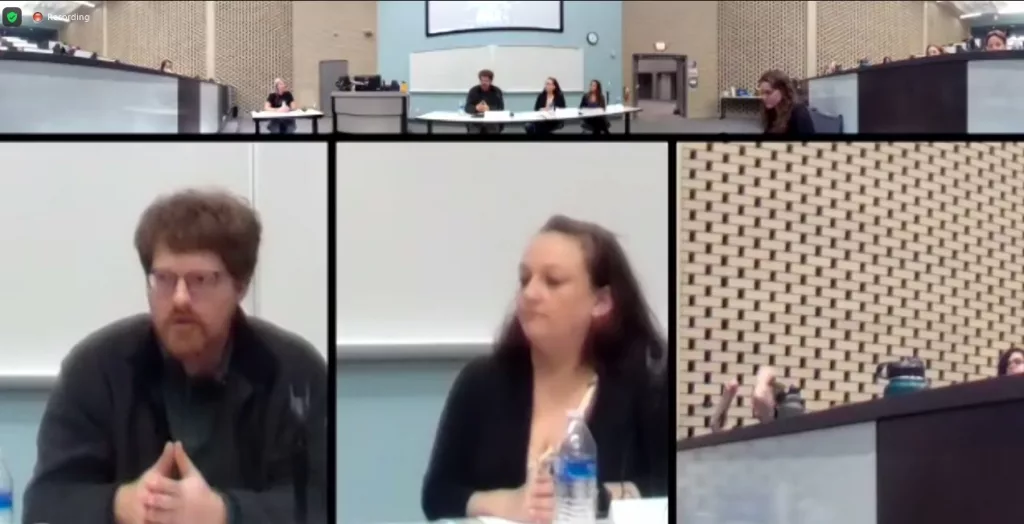A panel of experts across multiple fields joined together with honor students and faculty Thursday evening at Lake Michigan College to discuss the gun violence in schools and communities across the United States.
Panelists at the forum included Columbia University Health and Behavior Studies professor Dr. Sonali Rajan, State Rep. Joey Andrews, retired Army officer Ken Peterson and local emergency department nurses Adrianna Retberg and Karlye Visel.
Below, find a selection of answers from panelists on questions asked by students specifically regarding the question Is a good guy with a gun the best way to stop a bad guy with a gun?
Peterson: “I don’t think that’s realistic. The high capacity magazines of 20 rounds – now 30 in the military – means that you can get 20 rounds shot off before anybody takes any action against you. …
It’s not only about ensuring that we have red flag laws and gun safety, but it’s that we do something about curtailing our assault weapons, which are deadly. One of the things in the military is that you go through a two week course to qualify on a weapon, and then you go on out on the range and if you do qualify, and then you have to be requalified every year on a weapon.
Assault weapons are about being trained to kill. So what are we doing with assault weapons in a civilian sector? Do you really need that in order to kill a deer? I really don’t think you do. And it’s really making it very, very difficult to get the weapons out of the hands of those people where they don’t belong. … When you start talking about somehow teachers are going to carry weapons and somehow are going to protect us, how are they going to do that if they’re not qualified with those weapons?
I think we’ve got to look at: more competent, qualified security guards, use of an automated phone security system, red flag laws, universal background checks, gun safety laws, gun owner registrations, no sales of weapons between owners without a registered gun dealer officiating the sale, a ban on assault weapons and high capacity magazines.
… It isn’t just rifles, pistols are also assault weapons. We need to do something about that and, good guy with a weapon is not gonna stop a bad guy with a weapon – guaranteed.”
Andrews: “I think the, the relevant thing here is that the good guy with a gun concept is a fallacy. The people who I think are imagining this are kind of imagining themselves in a Clint Eastwood Western or something where they’re going to walk into a building and square off with the shooter, draw from the hip and … be the hero.
The thing to remember is that the shooter gets to determine when, where, and how the shooting happens. If you’re a good guy with a gun sitting down and eating at a restaurant and you’re putting a fork up to your mouth when the shooter opens fire, good luck. …
Being in a combat situation is totally different than being in a shooting range or out back in the woods behind your house. You are not going to respond the way that you think you are. You are not the hero that you think you are. …
We have a lot to do to address gun violence in this country, but the notion that arming more people is the solution is just completely misidentifying what the problem is and how these scenarios play out.”
Dr. Rajan: “There’s no data that has shown in any way. There’s no studies that have been done – we are doing one right now, so invite me back in a year and I’ll hopefully have some data to share with you about how this might play out specifically in schools. But there’s no data that suggests that arming, for example, teachers in the school would do anything to either reduce, deter a shooting from happening in the first place, nor reduce the lethality of a shooting once it was taking place.
Let’s think about what are teachers trained to do. They’re trained to teach and nurture and care for children in the middle of that situation. Or, we’re asking them to carry a loaded weapon and have the wherewithal in the middle of story hour to pull it out and with complete accuracy, aim at the person they’re intending to hurt.
Imagine if they, God forbid, hit one of the other children or one of their colleagues or a family member. I mean, the number of potential mishaps that could happen are unthinkable.
… How do we know who the good guy is versus the bad guy? How do police know when they arrive on the scene? It’s making the jobs of law enforcement who are trained to respond to these situations more challenging. And listen, I have family members who are gun owners. Again, this isn’t about gun ownership per se. This is about really trying to make sense of how we in these public spaces, right schools and in our neighborhoods and in the places where we live and work and play.”
Retberg: “I’m lucky to work at a hospital that has a great security department, but it would be very difficult if someone were to ask me, as a nurse, to carry a gun to protect patients when that’s not what I’m trained to do. As I’m busy providing patient care, it would not be beneficial for me to have a gun at all and try to diffuse a situation.”
Visel: “When I’m caring for a patient at the bedside, or I’m caring for a patient who’s a victim of gun violence, my priority is that patient, and ensuring that patient is safe and that I can provide lifesaving measures if needed. My priority is not protecting my staff. Thankfully we do work with a great security department, some of which are armed. But again, when law enforcement is responding and that scene now comes to the hospital, who is that good guy? Who is helping?”






